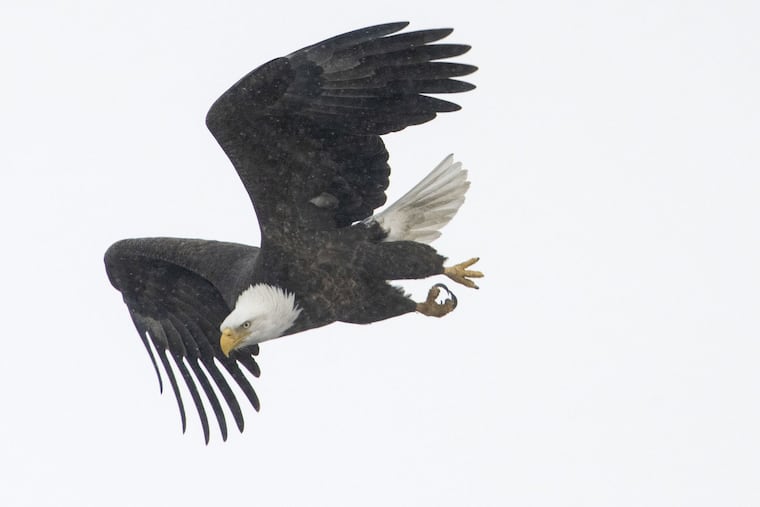It’s Superb Owl Sunday, and we’re singing the praises of Pennsylvania’s bird life
Two species of eagle and eight species of owl call the commonwealth home.

All right, fellow bird fans. There’s a big game this weekend featuring the Birds, sure. We’re wearing green and rooting for Jalen Hurts and Autumn Lockwood — the first Black woman coaching in the Super Bowl — and we’re dipping chips in dip.
But how much do you know about the other types of birds? Yes, I’m talking about literal feathers, beaks, eggs, the whole nine (or given Sunday’s game, should we say 100) yards. Birds endure. They adapt. There are so many reasons to love them.
Those other eagles
Pennsylvania is home to two species of eagles: the bald eagle and the golden eagle. In 1983, there were only three bald eagle nests left in Pennsylvania. By 2013, thanks to the combined efforts of the Canadian government and the Pennsylvania Game Commission to reintroduce the species, that number had rebounded to 300 nests statewide.
You can watch a livestream of two active bald eagle nests, the Farm Country Eagles at the top of a sycamore tree in an undisclosed, rural part of the state, and the Hanover Eagle at Codorus State Park. Bald eagle nests are massive — about 5 feet high and 2 feet wide, the largest of any North American bird. Female members of both species should be laying their eggs soon.
Golden eagles are migratory birds; they lay their eggs in the forests of northeastern Canada and travel south along the Appalachian Mountains to spend the winter in Virginia and West Virginia. In Pennsylvania, you can catch a glimpse of these eagles heading south between mid-October and early December, and on their way north in March and April. Most sightings occur in the Ridge and Valley Province between the Allegheny Front and the Kittatinny Ridge.
‘Superb Owls’
Any discussion of birds and the Super Bowl would be incomplete without a nod to the Superb Owls among us. According to Know Your Meme, the earliest known use of this (perhaps accidental) anagram online was in 2008, when Twitter user @shawnw exclaimed: “Superb Owl party tonight!”
Superb Owl party tonight!
— shawnw ✝️ (@shawnw) February 3, 2008
Yes, owls are superb. Every year, on this Sunday in February, I look forward to people posting their favorite poems and images and fun facts about owls in tandem with the football celebrations. Pennsylvania has eight species of owl, each excellent in its own right.
Barn owls have long legs, a golden-brown upper, and a heart-shaped face. They prefer open fields, where they can find small mammals to snack on. Barn owl populations in Pennsylvania have been declining for several decades due to the loss of farmland and grassland habitats for hunting. These owls don’t hoot; they hiss and scream.
Eastern screech owls live in tree hollows in cemeteries, city parks, and along the edges of streams — wherever there’s a good spot to nest and dine. They eat everything from grasshoppers to moths, mice, squirrels, rabbits, blue jays, and crayfish. Screech owls hunt by sitting on a branch and then pouncing on their prey from above. If you’d like to invite a screech owl into your backyard, the best way is to build a nest box.
Great horned owls have a deep hoot, a yellow-eyed stare, and are often referred to as the “tiger of the air” for their ferocious hunting skills. Their heads can swivel more than 180 degrees.
Snowy owls are native to the Arctic tundra, but they often travel south in the winter to find food and light. Last February, one touched down on a field in Lancaster County, though this is rare.
Barred owls are great singers, distinctive for their call: “Who cooks for you? Who cooks for you all?”
🎶Who cooks for you? Who cooks for you-all?🎶
— American Bird Conservancy (@ABCbirds) February 7, 2021
This classic bird call belongs to a well-known and beloved owl species. Have you heard it before?
Get in the spirit of #SuperbOwl Sunday and learn more about a truly superb owl, the Barred #Owl.https://t.co/1nEb6994JF pic.twitter.com/MKP4Gx98AU
Long-eared owls are nocturnal hunters who love eating mice, generally nest in evergreen conifers, and are threatened in Pennsylvania.
Short-eared owls spend their winters in Pennsylvania’s farmlands and wetlands, nest on the ground, and are on the state’s endangered species list — primarily because their nesting habitats have been lost to development.
Northern saw-whet owls are tiny — only 7 to 8 inches tall — and they are nocturnal, so they’re tough to see. The smallest Pennsylvania owl lives in dense woodlands, and they hunt and roost close to the ground.
Happy #SuperbOwl Sunday! Check out the over 1,500 faved owl observations on iNaturalist, including this Northern Saw-whet #Owl seen by zachsw. #owls #birds #nature #optoutside #strigiformeshttps://t.co/Wff4cIy7tN pic.twitter.com/jb1AueKjBy
— iNaturalist (@inaturalist) February 3, 2019
Let’s face it, all of these Pennsylvania owls (and eagles) are pretty superb. Sunday or any day, go birds — and go Birds.